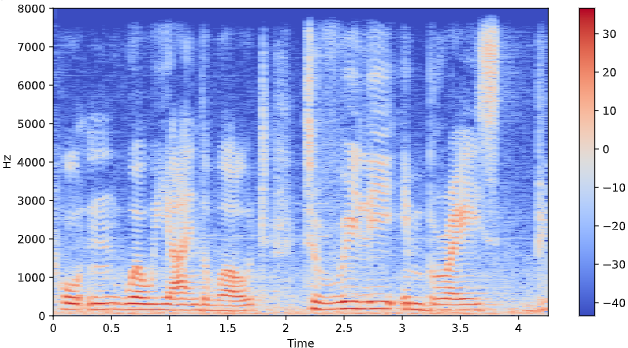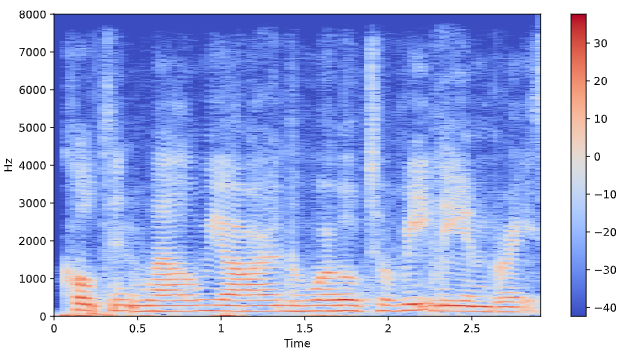FakeAVCeleb is a novel Audio-Video Multimodal Deepfake Detection dataset (FakeAVCeleb), which contains not only deepfake videos but also respective synthesized cloned audios.
If you would like to download the FakeAVCeleb dataset, please fill out the Google request form and, once accepted, we will send you the link to our download script.sh
Once, you obtain the download link, please see the download section in our Dataset site. You can also find details about our FakeAVCeleb dataset.
We recommend the installation using the requilrements.txt contained in this Github.
python==3.8.0
numpy==1.20.3
torch==1.8.0
torchvision==0.9.0
matplotlib==3.3.4
tqdm==4.61.2
scikit-learn
pandas
pip install -r requirements.txt| Dataset | Real Videos | Fake Videos | Total Videos | Rights Cleared | Agreeing subjects | Total subjects | Methods | Real Audio | Deepfake Audio | Fine-grained Labeling |
|---|---|---|---|---|---|---|---|---|---|---|
| UADFV | 49 | 49 | 98 | No | 0 | 49 | 1 | No | No | No |
| DeepfakeTIMIT | 640 | 320 | 960 | No | 0 | 32 | 2 | No | Yes | No |
| FF++ | 1000 | 4,000 | 5,000 | No | 0 | N/A | 4 | No | No | No |
| Celeb-DF | 590 | 5,639 | 6,229 | No | 0 | 59 | 1 | No | No | No |
| Google DFD | 0 | 3,000 | 3,000 | Yes | 28 | 28 | 5 | No | No | No |
| DeeperForensics | 50,000 | 10,000 | 60,000 | Yes | 100 | 100 | 1 | No | No | No |
| DFDC | 23,654 | 104,500 | 128,154 | Yes | 960 | 960 | 8 | Yes | Yes | No |
| KoDF | 62,166 | 175,776 | 237,942 | Yes | 403 | 403 | 6 | Yes | No | No |
| FakeAVCeleb | 500 | 19,500 | 20,000 | No | 0 | 500 | 4 | Yes | Yes | Yes |
-m model name = [MESO4, MESOINCEPTION4, XCEPTION, EFFICIENTB0, F3NET, LIPS, XRAY, HEADPOSE, EXPLOTING, CAPSULE]
-v path of video data
-a path of audio data
-vm path of video model (For evluation)
-am path of audio model (For evluation)
-sm path to save best-model while training
-l learning late (For training)
-me number of epoch (For training)
-nb batch size
-ng gpu device to use (default=0) can be 0,1,2 for multi-gpu
-vr validation ratio on trainset
-ne patient number of early stopping
-en True or False, It would be decided whether ensemble (Only for evaluation)- Note that it must be required to write the model name and either video informs(data path, model path) or audio informs(data path, model path)
- More, the model name should be picked one of these : [MESO4, MESOINCEPTION4, XCEPTION]
To train and evaluate the model(s) in the paper, run this command:
-
1. Unimodal
python triain_main.py -m=<model name> -v=<data path for video> -a=<data path for audio>After train the model, you can soely evaluate the result.
python eval_main.py -m=<model name> -v=<data path for video> -vm=<model path for video> -a=<data path for audio> -am=<model path for audio>you can evaluate the result of Ensemble Prediction.
python eval_main.py -en=True -m=<model name> -v=<data path for video> -vm=<model path for video> -a=<data path for audio> -am=<model path for audio> -
2. Multimodal
-
For using Headpose, Exploting, and Capsule-Forensics, please cite and download for running codes.
Headpose :https://bitbucket.org/ericyang3721/headpose_forensic/src/master/
Exploting :https://github.com/FalkoMatern/Exploiting-Visual-Artifacts
Capsule-Forensics :https://github.com/nii-yamagishilab/Capsule-Forensics
- Frame-level AUC scores (%) of various methods on compared datasets.
| Dataset | UADFV | DF-TIMIT (LQ) | DF-TIMIT (HQ) | FF-DF | DFD | DFDC | Celeb-DF | FakeAVCeleb |
|---|---|---|---|---|---|---|---|---|
| Capsule | 61.3 | 78.4 | 74.4 | 96.6 | 64.0 | 53.3 | 57.5 | 70.9 |
| HeadPose | 89.0 | 55.1 | 53.2 | 47.3 | 56.1 | 55.9 | 54.6 | 49.0 |
| VA-MLP | 70.2 | 61.4 | 62.1 | 66.4 | 69.1 | 61.9 | 55.0 | 67.0 |
| VA-LogReg | 54.0 | 77.0 | 77.3 | 78.0 | 77.2 | 66.2 | 55.1 | 67.9 |
| Xception-raw | 80.4 | 56.7 | 54.0 | 99.7 | 53.9 | 49.9 | 48.2 | 71.5 |
| Xception-comp | 91.2 | 95.9 | 94.4 | 99.7 | 85.9 | 72.2 | 65.3 | 77.3 |
| Meso4 | 84.3 | 87.8 | 68.4 | 84.7 | 76.0 | 75.3 | 54.8 | 60.9 |
| MesoInception4 | 82.1 | 80.4 | 62.7 | 83.0 | 75.9 | 73.2 | 53.6 | 61.7 |
- Spectrogram of Real audio and Fake audio from left to right.
If you use the FakeAVCeleb data or code please cite:
@misc{khalid2021fakeavceleb,
title={FakeAVCeleb: A Novel Audio-Video Multimodal Deepfake Dataset},
author={Hasam Khalid and Shahroz Tariq and Simon S. Woo},
year={2021},
eprint={2108.05080},
archivePrefix={arXiv},
primaryClass={cs.CV}
}
If you have any questions, please contact us at hasam.khalid/shahroz/kimminha@g.skku.edu.
[1] Huy H Nguyen, Junichi Yamagishi, and Isao Echizen. Use of a capsule network to detect fake images and videos. arXiv preprint arXiv:1910.12467, 2019.
[2] Xin Yang, Yuezun Li, and Siwei Lyu. Exposing deep fakes using inconsistent head poses. In ICASSP 2019-2019 IEEE International Conference on Acoustics, Speech and Signal Processing (ICASSP), pages 8261–8265. IEEE, 2019.
[3] Falko Matern, Christian Riess, and Marc Stamminger. Exploiting visual artifacts to expose deepfakes and face manipulations. In 2019 IEEE Winter Applications of Computer Vision Workshops (WACVW), pages 83–92. IEEE, 2019.
[4] Andreas Rossler, Davide Cozzolino, Luisa Verdoliva, Christian Riess, Justus Thies, andMatthias Nießner. Faceforensics++: Learning to detect manipulated facial images. In Proceedings of the IEEE/CVF International Conference on Computer Vision, pages 1–11, 2019.
[5] Darius Afchar, Vincent Nozick, Junichi Yamagishi, and Isao Echizen. Mesonet: a compact facial video forgery detection network. In 2018 IEEE International Workshop on Information Forensics and Security (WIFS), pages 1–7. IEEE, 2018.
[6] Conrad Sanderson and Brian C Lovell. Multi-region probabilistic histograms for robust and scalable identity inference. In International conference on biometrics, pages 199–208. Springer, 2009.
[7] Yuezun Li, Xin Yang, Pu Sun, Honggang Qi, and Siwei Lyu. Celeb-df: A large-scale challenging dataset for deepfake forensics. In Proceedings of the IEEE/CVF Conference on Computer Vision and Pattern Recognition, pages 3207–3216, 2020.
[8] Liming Jiang, Ren Li, Wayne Wu, Chen Qian, and Chen Change Loy. Deeperforensics-1.0: A large-scale dataset for real-world face forgery detection. In Proceedings of the IEEE/CVF Conference on Computer Vision and Pattern Recognition, pages 2889–2898, 2020.
[9] Brian Dolhansky, Joanna Bitton, Ben Pflaum, Jikuo Lu, Russ Howes, Menglin Wang, and Cristian Canton Ferrer. The deepfake detection challenge dataset. arXiv preprint arXiv:2006.07397, 2020.
[10] Patrick Kwon, Jaeseong You, Gyuhyeon Nam, Sungwoo Park, and Gyeongsu Chae. Kodf: A large-scale korean deepfake detection dataset. arXiv preprint arXiv:2103.10094, 2021.
[11] Huy H Nguyen, Junichi Yamagishi, and Isao Echizen. Use of a capsule network to detect fake images and videos. arXiv preprint arXiv:1910.12467, 2019.
[12] Xin Yang, Yuezun Li, and Siwei Lyu. Exposing deep fakes using inconsistent head poses. In ICASSP 2019-2019 IEEE International Conference on Acoustics, Speech and Signal Processing (ICASSP), pages 8261–8265. IEEE, 2019.
[13] Matern, Falko and Riess, Christian and Stamminger, Marc. Exploiting visual artifacts to expose deepfakes and face manipulations. In 2019 IEEE Winter Applications of Computer Vision Workshops (WACVW), 2019.
The data can be released under the FakeAVCeleb Request Forms, and the code is released under the MIT license.
Copyright (c) 2021


